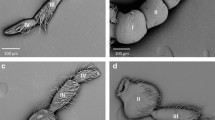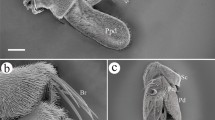Summary
The sensilla are associated with 6 enveloping cells. The innermost enveloping cell (e 1) secretes the dendritic sheath (=thecogen cell). All other enveloping cells are involved in the formation of the outer cuticular apparatus in secreting the cuticle of a definite region of the new hair shaft.
The development of the new sensilla begins when an exuvial space expands between old cuticle and epithelium. The newly forming hair shafts lie folded back in an invagination of the epidermal tissue. Only a distal shaft part projects into the free exuvial space. The cuticle of the distal and middle shaft region is secreted by the three middle enveloping cells (e 2–e 4) (=trichogen cells), which are arranged around the dendritic sheath.
The wall of the cylinder, in which the distal shaft is situated, is formed by the cuticle of the future proximal shaft region. It is secreted by the outer enveloping cells (e 5 and e 6). Furthermore, both enveloping cells form the hair socket (=trichogen-tormogen cells).
The outer dendritic segments encased within a dendritic sheath run up through the newly formed hair shaft and continue to the old cuticular apparatus. The connection between sensory cells and old hair shaft is maintained until ecdysis. On ecdysis the old cuticle is shed and the newly formed shaft of the sensillum is everted like the invaginated finger of a glove. The dendritic sheath and the outer dendritic segments break off at the tip of the new hair shaft. Morphologically this moulting process ensures that the sensitivity of the receptors is maintained until ecdysis.
The internal organization of the sensory cells shows no striking changes during the moulting cycle. An increased number of vesicles is accumulated distally within the inner dendritic segments and distributed throughout the outer segments of the dendrites. The cytoplasmic feature of the enveloping cells indicates that synthesis and release of substances for the cuticular apparatus of the new sensillum take place.
Similar content being viewed by others
References
Aiken, D. E., 1973: Proedysis, setal development, and molt prediction in the American lobster (Homarus americanus). J. Fish. Res. Board Can.30, 1337–1344.
Altner, H., Thies, G., 1972: Reizleitende Strukturen und Ablauf der Häutung an Sensillen einer euedaphischen Collembolenart. Z. Zellforsch.129, 196–216.
Andersson, A., 1975: The ultrastructure of the presumed chemoreceptor aesthetasc “Y” of a cypridid ostracode. Zool. Scr.4, 151–158.
Ball, E. E., Cowan, A. N., 1977: Ultrastructure of the antennal sensilla ofAcetes (Crustacea, Decapoda, Natantia, Sergestidae). Phil. Trans. R. Soc. (Lond.)B277, 429–457.
Crouau, Y., (1978 a): Organes sensoriels d'un Mysidacé souterrain anophthalme,Antromysis juberthiei: étude ultrastructurale des aesthetascs. Bull. Mus. natn. Hist, nat., Paris, 3e sér., no. 513, Zoologie,352, 165–175.
—, (1978 b): Ultrastructure des phanères spinulés mécanorécepteurs d'un Crustacé Mysidacé souterrain anophthalme. C. R. Acad. Sc. (Paris)D287, 1215–1218.
Drach, P., Tchernigovtzeff, C., 1967: Sur la méthode de détermination des stades d'intermue et son application générale aux Crustacées. Vie et MilieuA 18, 595–609.
Ernst, K.-D., 1972: Die Ontogenie der basiconischen Riechsensillen auf der Antenne vonNecrophorus (Coleoptera). Z. Zellforsch.129, 217–236.
Gaffal, K.-P., Bassemir, U., 1974: Vergleichende Untersuchung modifizierter Cilien-strukturen in den Dendriten mechano- und chemosensitiver Rezeptorzellen der BaumwollwanzeDysdercus und der LibelleAgrion. Protoplasma82, 177–202.
Gnatzy, W., 1978: Development of the filiform hairs on the cerci ofGryllus bimaculatus Deg. (Saltatoria, Gryllidae). Cell Tiss. Res.187, 1–24.
Green, J. R., Neff, M. R., 1972: A survey of the fine structure of the integument of the fiddler crab. Tissue and Cell4, 137–171.
Guse, G.-W., 1978: Antennal sensilla ofNeomysis integer (Leach). Protoplasma95, 145–161.
—, 1979: Feinstruktur der Aesthetasken vonNeomysis integer (Leach) (Crustacea, Mysidacea). Zool. Anz.203, 170–176.
- 1980: Fine structure of sensilla during moulting inNeomysis integer (Leach) (Crustacea, Mysidacea). Experientia (in press).
Harris, D. J., 1977: Hair regeneration during moulting in the spiderCiniflo similis (Araneae, Dyctinidae). Zoomorphologie88, 37–63.
Haupt, J., Coineau, Y., 1978: Moulting and morphogenesis of sensilla in a prostigmate mite (Acari, Actinotrichida, Actinedida: Caeculidae). I. Mechanoreceptive bristles. Cell Tiss. Res.186, 63–79.
Keil, T., 1976: Sinnesorgane auf den Antennen vonLithobius forficatus L. (Myriapoda, Chilopoda). I. Die Funktionsmorphologie der „Sensilla trichodea“. Zoomorphologie84, 77–102.
Kümmel, G., Claassen, H., Keller, R., 1970: Zur Feinstruktur von Cuticula und Epidermis beim FlußkrebsOrconectes limosus während eines Häutungszyklus. Z. Zellforsch.109, 517–551.
Larink, O., 1976: Entwicklung und Feinstruktur der Schuppen bei Lepismatiden und Machiliden (Insecta, Zygentoma und Archaeognatha). Zool. Jb. Anat.95, 252–293.
Locke, M., Krishnan, N., 1971: Distribution of phenoloxidases and polyphenols during cuticle formation. Tissue and Cell3, 103–126.
Marshall, A. T., 1973: Vesicular structures in the dendrites of an insect olfactory receptor. Tissue and Cell5, 233–241.
Mead, F., Gabouriaut, D., Corbière-Tichané, G., 1976: Structure de l'organe sensoriel apical de l'antenne chez l'isopode terrestreMetoponorthus sexfasciatus Budde-Lund (Crustacea, Isopoda). Zoomorphologie83, 253–269.
Munn, E. A., Klepal, W., Barnes, H., 1974: The fine structure and possible function of the sensory setae of the penis ofBalanus balanoides (L.). J. exp. mar. Biol. Ecol.14, 89–98.
Neville, A. C., 1975: Biology of the arthropod cuticle. Berlin-Heidelberg-New York: Springer.
Reaka, M. L., 1975: Molting in stomatopod crustaceans. I. Stages of the molt cycle, setagenesis, and morphology. J. Morph.146, 55–80.
Rieder, N., 1979: Die Borsten an den Blattbeinen vonTriops cancriformis Bosc. (Crustacea, Notostraca) während der Häutungsvorbereitung. II. Die Ultrastruktur der Borsten vom Typ 2 and 3. Zool. Anz.202, 317–330.
Risler, H., 1973: Mechanorezeptoren an der Geißel der Antennula vonPalaemon serratus. Verh. dtsch. zool. Ges.66, 42–47.
—, 1977: Die Sinnesorgane der Antennula vonPorcellio scaber Latr. (Crustacea, Isopoda). Zool. Jb. Anat.98, 29–52.
—, 1978: Die Sinnesorgane der Antennula vonLigidium hypnorum (Cuvier) (Isopoda, Crustacea). Zool. Jb. Anat.100, 514–541.
Schmidt, K., Gnatzy, W., 1971: Die Feinstruktur der Sinneshaare auf den Cerci vonGryllus bimaculatus Deg. (Saltatoria, Gryllidae). II. Die Häutung der Faden- und Keulenhaare. Z. Zellforsch.122, 210–226.
Snow, P. J., 1973: Ultrastructure of the aethetasc hairs of the littoral decapod,Paragrapsus gaimardii. Z. Zeilforsch.138, 489–502.
Tchernigovtzeff, C., 1976: Sur l'organisation des matrices sétigères chez deux Crustacés Malacostracés, étudiée au microscope électronique. C. R. Acad. Sc.D 282, 727–729.
Author information
Authors and Affiliations
Rights and permissions
About this article
Cite this article
Guse, G.W. Development of antennal sensilla during moulting inNeomysis integer (Leach) (Crustacea, Mysidacea). Protoplasma 105, 53–67 (1980). https://doi.org/10.1007/BF01279849
Received:
Accepted:
Issue Date:
DOI: https://doi.org/10.1007/BF01279849




